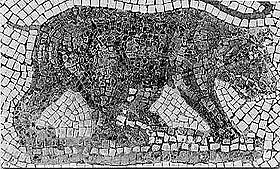Urso-do-atlas
| Urso-do-atlas | |||||||||||||||||
|---|---|---|---|---|---|---|---|---|---|---|---|---|---|---|---|---|---|
| Estado de conservação | |||||||||||||||||
 Extinta | |||||||||||||||||
| Classificação científica | |||||||||||||||||
| |||||||||||||||||
| Nome trinomial | |||||||||||||||||
| Ursus arctos crowtheri Schinz, 1844 | |||||||||||||||||
A nomenclatura urso-do-atlas (Ursus arctos crowtheri) é aplicada a uma extinta população ou populações de urso-pardo na África. Os ursos-pardos foram introduzidos na África levados pelos romanos, que importavam ursos para espetáculos.[1][2]
Distribuição e descrição
[editar | editar código-fonte]O Urso-do-atlas foi o único urso africano a sobreviver até os tempos modernos. Habitava a região da Cordilheira do Atlas, ocupando uma área do Marrocos à Líbia, é considerado hoje como extinto. Tinha coloração marrom escura e mancha branca no focinho. A pelagem nas patas, tórax e abdome podiam ser alaranjadas e os pêlos mediam cerca de 10 cm. O focinho e as garras eram menores que a de um urso negro, porém mais robustas. O urso-do-atlas podia medir até 2,70 m e pesar 450 kg.[3] Aparentemente alimentava-se de raízes, bolotas e nozes.[4] O urso-do-atlas tinha hábitos alimentares de um herbívoro, mas como a maioria dos ursos modernos são omnívoros, acredita-se que o Urso-atlas se alimentava de carne também .[3]
Origem
[editar | editar código-fonte]A origem do Urso-do-atlas é desconhecida, um estudo genético foi incapaz de associar a qualquer urso pardo, mas tem uma fraca porém significante semelhança de DNA mitocondrial com o urso-polar.[1] Ursos polares aparecem em pinturas rupestres em Andaluzia, na Espanha, lugar separado da região da Cordilheira do Atlas por uma pequena área de mar, o que não é muito para um urso polar.[5]
Ver também
[editar | editar código-fonte]Referências
- ↑ a b Calvignac, S.; Hughes, S.; Tougard, C.; Michaux, J.; Thevenot, M.; Philippe, M.; Hamdine, W.; Hanni, C. (2008). «Ancient DNA evidence for the loss of a highly divergent brown bear clade during historical times.». Mol. Ecol. 17: 1962–1970. doi:10.1111/j.1365-294x.2008.03631.x
- ↑ Calvignac, Sebastien; Hughes, Sandrine; Hanni, Catherine (2009). «Genetic diversity of endangered brown bear (Ursus arctos) populations at the crossroads of Europe, Asia and Africa». Diversity and Distributions. 15: 742–750. doi:10.1111/j.1472-4642.2009.00586.x. Consultado em 18 de março de 2015
- ↑ a b "Atlas bear facts", Bob Strauss, 2014
- ↑ Bruin: The Grand Bear Hunt, Mayne Reid, Ticknor and Fields, 1865
- ↑ Pagano, A.M.; Durner, G.M.; Amstrup, S.C.; Simac, K.S.; York, G.S. (2012). «Long-distance swimming by polar bears (Ursus maritimus) of the southern Beaufort Sea during years of extensive open water.». Canadian Journal of Zoology. 90: 663–676. doi:10.1139/z2012-033
Text is available under the CC BY-SA 4.0 license; additional terms may apply.
Images, videos and audio are available under their respective licenses.

